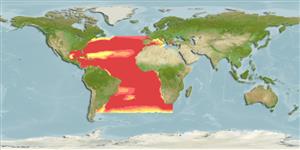Common names from other countries
Environment: milieu / climate zone / depth range / distribution range
Ecologie
marien; oceanodroom (Ref. 51243); diepte 0 - 150 m (Ref. 43), usually 0 - 100 m (Ref. 55219). Subtropical; 22°C - ? (Ref. 12451); 47°N - 45°S, 99°W - 27°E (Ref. 55219)
Atlantic Ocean: roughly from 45°N to 45°S in the southwestern Atlantic and 35°S in the southeastern Atlantic. Records from the Mediterranean Sea, and from Bretagne, France seem to correspond to a few straying individuals. Classified as 'reduced' (Ref. 12451). It is unclear whether there are two separate stocks or a single population in the Atlantic. Highly migratory species.
Lengte bij maturiteit / Grootte / Gewicht / Leeftijd
Maturity: Lm 164.0, range 130 - ? cm
Max length : 300 cm TL mannelijk / geslacht onbekend; (Ref. 4770); common length : 210 cm TL mannelijk / geslacht onbekend; (Ref. 5217); max. gepubliceerd gewicht: 82.5 kg (Ref. 43)
Dorsale stekels (totaal) : 0; Dorsale zachte stralen (totaal) : 43 - 52; Anale stekels: 0; Anale zachte stralen: 17 - 23. Blue-black above, silvery white and splattered with brown on the sides, silvery white below; sometimes with more than 15 rows of obscure whitish stripes; 1st dorsal fin dark blue with black dots; 2nd dorsal fin dark blue; pectorals blackish brown, with tinges of silvery white in some specimens; pelvic fins blue-black with a black fin membrane; caudal fin blackish brown.
Usually above the thermocline. Its distribution varies seasonally, reaching higher latitudes in both the northern and southern hemispheres only during the respective warm seasons. Usually found in deep (over 100 m) blue water with surface temperatures over 22°C and salinities of 35 to 37 ppt. Currents of 0.5 to 2 knots occur over much of its habitat. Feeds on fishes and squids. Females grow larger (Ref. 4770). Flesh is of excellent quality. Marketed fresh and frozen.
Levenscyclus en paargedrag
Maturities | Voortplanting | Spawnings | Egg(s) | Fecundities | Larven
Migrates into subtropical waters to spawn, with peak spawning occurring in early summer. The spawning areas are found in deep and blue oceanic waters, generally at high temperatures ranging from 20° to 29°C except in the southern Atlantic gyrals, and high surface salinities (over 35 ppt).
Nakamura, I., 1985. FAO species catalogue. Vol. 5. Billfishes of the world. An annotated and illustrated catalogue of marlins, sailfishes, spearfishes and swordfishes known to date. FAO Fish. Synop. 125(5):65p. Rome: FAO. (Ref. 43)
Status op de Rode Lijst van het IUCN (Ref. 130435)
CITES (Ref. 128078)
Not Evaluated
Gevaar voor de mens
Harmless
Gebruik door de mens
Visserij: van minder commercieel belang; sportvis: ja
Tools
Speciale rapporten
Download XML
Internetbronnen
Estimates based on models
Preferred temperature (Ref.
115969): 15.7 - 27.9, mean 25.1 (based on 1614 cells).
Fylogenetische diversiteitsindex (Ref.
82804): PD
50 = 0.7505 [Uniqueness, from 0.5 = low to 2.0 = high].
Bayesian length-weight: a=0.00447 (0.00193 - 0.01034), b=3.14 (2.94 - 3.34), in cm Total Length, based on LWR estimates for this (Sub)family-body shape (Ref.
93245).
Trofisch niveau (Ref.
69278): 4.5 ±0.4 se; based on diet studies.
Weerstandsvermogen (Ref.
120179): Gemiddeld, minimale populatieverdubbelingstijd 1,4-4,4 jaar (K=0.58; assuming tm >=2).
Prior r = 0.24, 95% CL = 0.16 - 0.36, Based on 1 full stock assessment.
Fishing Vulnerability (Ref.
59153): Moderate vulnerability (41 of 100).
Climate Vulnerability (Ref.
125649): High vulnerability (62 of 100).
